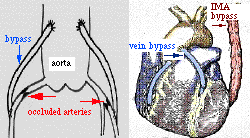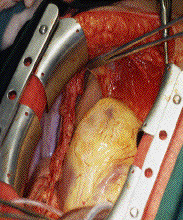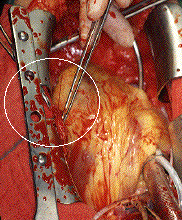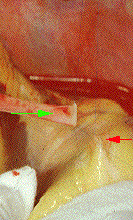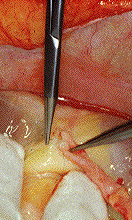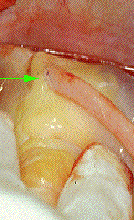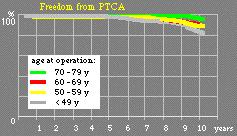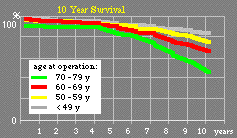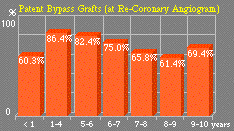|
|
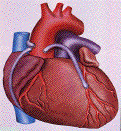 Aortocoronary
bypass surgery means that one or more bypass grafts are implanted
between the aorta and the coronary blood vessel. If occlusive vascular
disease limits the blood flow to the heart, the bypass graft bridges the
occluded or diseased heart blood vessel
(coronary artery)
and brings new blood to the heart. Saphenous veins
(from the leg)
or arteries (like the IMA =
internal mammary artery) are commonly used
as grafts for coronary bypass surgery. Aortocoronary
bypass surgery means that one or more bypass grafts are implanted
between the aorta and the coronary blood vessel. If occlusive vascular
disease limits the blood flow to the heart, the bypass graft bridges the
occluded or diseased heart blood vessel
(coronary artery)
and brings new blood to the heart. Saphenous veins
(from the leg)
or arteries (like the IMA =
internal mammary artery) are commonly used
as grafts for coronary bypass surgery. |
|
|
After thoracotomy (opening of the chest) the left IMA (internal mammary artery) is harvested. Simultaneously, a segment of the saphenous vein (vein of the leg) is prepared for the aorto- coronary bypass operation. Intraoperative photo (left) showing the heart and the harvested IMA. Photo on the right (white circle) showing the IMA being prepared for bypass grafting. |
|
|
|
After induction of extra- corporeal circulation the aorta is x-clamped, the coronary arteries are exposed, opened and the IMA is anastomosed (sutured) into the coronary artery. Intraoperative photo (left) showing the anastomosis of the IMA to the coronary artery. Photo on the right showing the IMA-bypass to the coronary artery (LAD), now supplying arterial blood to the heart muscle - bypassing the occluded coronary artery. |
|
|
|
|
|
Demonstrating additional vein grafting: left: coronary artery is exposed (<-), the vein prepared (->). middle: the vein is sutured into the coronary artery. right: the bypass is finished (->). |
|
|
Annual aortocoronary bypass
operations since 1984 (orange bars) Included in this data are all re-operations (patients who have undergone previous coronary bypass surgery before), currently about 11% of all coronary bypass procedures. The overall perioperative mortality for all 24.888 coronary bypass operations (incl. re-operations) since 1984 in our clinic: 1.2% |
|
|
|
| Freedom from PTCA 10 years after surgery for all patients is 88.9%. | Freedom from reoperation 10 years after surgery for all patients is 91.0%. |
|
|
|
| The 10 year survival after surgery for all patients is 71.9% - split according to age at the time of surgery. | Patent saphenous vein bypass grafts assessed at re-coronary angiogram studies during the 10 year follow-up period. |
